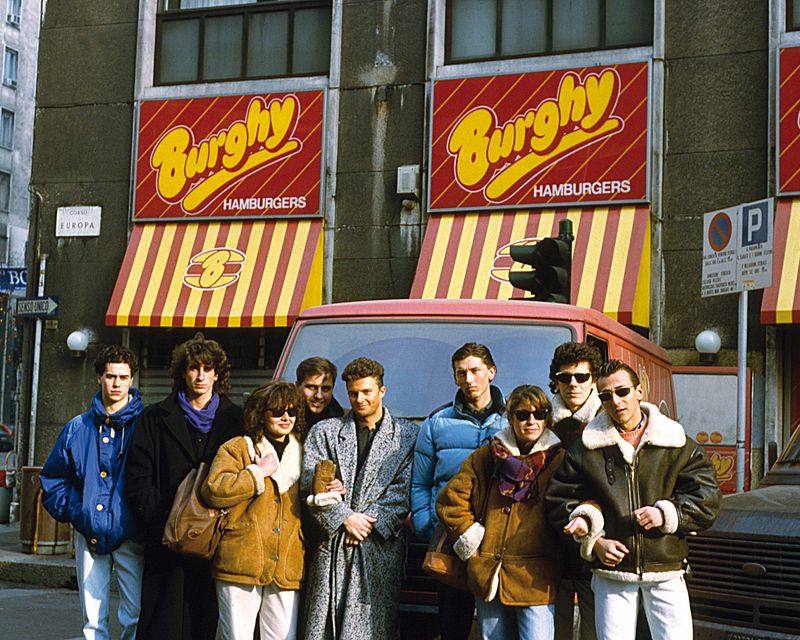THE JOURNAL

Paninari meeting near the Burghy restaurant in Piazza San Babila, Milan, 1986. Photograph by Mondadori Portfolio/Getty Images
It sounds ridiculous – and in some ways, it is – but for a brief period around 40 years ago, a group of ostentatious Italian youths who liked to loiter outside of sandwich shops had a role in shaping the way we have dressed ever since. In early 1980s Milan, affluent teenagers and twentysomethings started to congregate first at a small snack bar called Il Panino in Piazza Liberty, and later at a branch of a newly opened burger chain, Burghy, in Piazza San Babila. In a matter of months, the “paninari” (derived from panino, the Italian word for sandwich) were known across Italy.
They rode Vespas and Day-Glo Ducatis, wore brightly coloured Moncler and Stone Island puffer jackets, cropped light-wash denim, Argyle socks, chunky Sebago deck shoes and sunglasses by Ray-Ban, embracing American consumerism and British new-wave music. Originally an offshoot of football terrace culture, akin to casuals in England, the paninari quickly developed a collective philosophy based on the core principals of hanging out, having a good time and looking sharp while doing it.
“Throughout the 1980s, the terraces in Northern Italy were a stylish place to be,” says David Hellqvist, a writer, creative director and the founder of Document Studios. “But if you were a paninaro, you’d much rather lounge at the local cafés, talking to friends while sipping on an Aperol spritz. You’d probably wear similar pieces, something peacocky, but without the accompanying violence.
“The clothes were expensive and worn as status symbols,” Hellqvist says. “A lot of the paninaro wardrobe was quite colourful, which is a traditional ‘well-off’ palette – think the Horse and Hound set in raspberry chinos and bright socks.”

A paninaro posing in front of Burghy in Piazza San Babila, Milan, 1986

Paninaro style, Milan, 1986. Photographs by Mondadori Portfolio/Getty Images
The Pet Shop Boys even released a song named, simply, “Paninaro”. Its lyrics capturing the flashy, hedonistic tastes of the group: “Girls, boys, arts, pleasure/Paninaro, Paninaro, oh, oh, oh/Food, cars, travel, food, cars, travel, travel/New York, New York, New York/Paninaro, Paninaro, oh, oh, oh/Armani, Armani, A-A-Armani, Versace, Cinque”.
“We first saw the paninari on the streets of Milan in 1986,” Pet Shop Boys’ Neil Tennant told The New York Times in 2008. “We liked that it was a youth cult that was mainstream, as opposed to the more underground goths. They wore their jeans at ankle length, yachting shoes or Timberlands and Emporio Armani tops – it was very ‘fashion’. Being big in Italy was a glamorous fantasy for us, and the look fit in with [our] fashion sensibility.”

Men riding scooters in Florence, Italy, 1990. Photograph by Flo Smith/Alamy
In Subculture: The Meaning Of Style, Dick Hebdige’s influential 1979 book, which covers groups like the Teddy boys, mods, skinheads and punks, the author argues that all subcultures experience the same trajectory. Beginning with resistance and a sense of intrigue from the wider public, entrepreneurial individuals soon find ways to package the music and fashion of the zeitgeist for a larger, more mainstream audience.
“In this way,” Hebdige writes, “what was once subversive, rebellious and radical, is now contained. For this reason, it is often the case that the moment when dominant society begins to recognise a subculture is the moment that the resistant power of the subculture begins to die.”
Looking at photos from that era now, there are clear parallels between paninaro and contemporary menswear. The washed denim, chunky boots and boat shoes, branded sweatshirts and premium outerwear in bright colours from Stone Island, Moncler and C.P. Company. A refraction of prep and Ivy style with a sense of 1980s optimism and European panache. (The haircuts haven’t stood the test of time quite so well, though.)

Paninari outside a fast-food restaurant, Milan, 1987. Photograph by Mondadori Portfolio/Getty Images
“I can see a link to the premium sportswear that dominates today,” Hellqvist says. “Obviously, a lot of those paninaro brands from the 1990s are still here, but more than the brands themselves, I think the look of the past can be seen in today’s sprezzatura attitude. There’s a joy in the casual luxury of colours, that ‘look at me’ confidence a well-made Italian wardrobe says so well.”
The paninari imagined their own utopia, complete with a moveable clubhouse and immaculate uniforms in primary colours, even if its peak only lasted a few short years, withering as it was co-opted by a wider, more mainstream audience, along with the arrival of the 1990s, and with it an edgier, slightly gloomier aesthetic.
As The Guardian noted in 2023: “They presented themselves as the spirit of the time, a subculture of the winners, the cool guys who made money – or were good at giving the impression they did.”
The people featured in this story are not associated with and do not endorse MR PORTER or the products shown